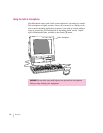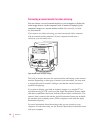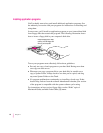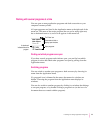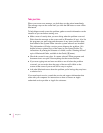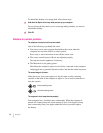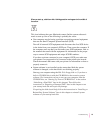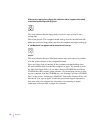
Using Power Macintosh application programs
Your Macintosh is compatible with most application programs intended for
use with Macintosh computers. But certain programs are designed especially
for Power Macintosh computers. (These are sometimes called “native”
applications.) You’ll find that these programs take best advantage of your
computer’s speed.
Special memory requirements
Some Power Macintosh programs may be slightly larger than other programs
and may take up more memory. If you find that you are running out of
memory when you use your Power Macintosh programs, you can use space
on your computer’s hard disk as additional memory. For instructions on how
to use hard disk space as memory, see the “Memory” topic of Macintosh
Guide, available in the Guide (h) menu.
You can also add more memory to your computer, as described in “Expanding
Memory” in Chapter 3.
Shared libraries
Power Macintosh programs use special files called shared libraries. These files
help the programs to run more efficiently, and can be used by more than one
Power Macintosh program simultaneously. Any necessary shared libraries
are installed automatically in the System Folder when you install Power
Macintosh programs.
If one of these programs requires a shared library and there is not enough
memory available for the shared library, you’ll see a message that the program
could not be opened because of insufficient system memory. If this happens,
see the “Memory” topic of Macintosh Guide, available in the Guide (h)
menu, for instructions on turning on virtual memory.
If a required shared library is missing, you’ll see a message that the program
could not be opened because the shared library could not be found. If this
happens, follow the directions that came with your program to reinstall the
program. If the shared library is still missing, contact the program’s
manufacturer for assistance.
43
Installing and Using Application Programs



